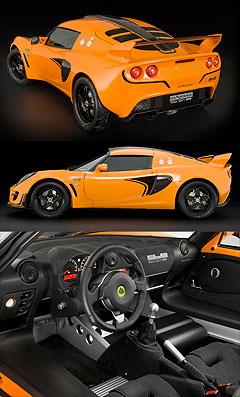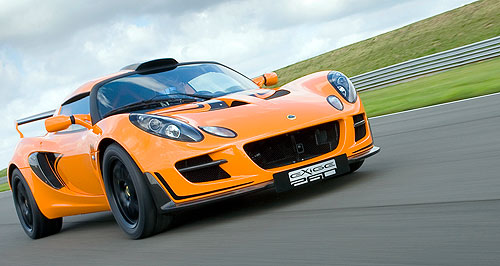Make / Model Search
New models - Lotus - Exige - Cup 260 coupeFirst look: Lotus tweaks 260 CupTrack star: Lotus has given its "most focussed" Exige S Cup 260 a new light-weight rear wing among a series of modifications. The Lotus Exige S-based road-going track racer modified for improved efficiency31 Aug 2009 LOTUS has upgraded its track-focused Exige Cup 260 with modifications for better handling, reduced fuel consumption, less emissions and improved aerodynamics. As with the 2009MY version released in March, the 2010MY Cup 260 is a development of the Exige S, and available now on special order only from $139,990 – the same as the old version – for a 4.5-month delivery time. Dubbed the “most focussed” Exige ever, the latest Cup 260 builds on the existing model’s 38kg weight loss compared with its Cup 240 predecessor while adopting design and technical cues from the Exige GT3 racer. Also seen on this year’s $114,990 Exige S update, the Cup 260 sprouts a lightweight and unpainted carbon chord composite rear wing that is 181mm wider and mounted 46mm higher and 61mm further back than on the existing model. A rethink of the way it is mounted to the rear bodyshell improves structural properties as well as airflow, with the upshot being a 30 per cent increase in rear chassis stiffness. The resulting sturdier suspension pick-up points in turn make for better tyre contact patch control. Frontal drag also drops due to a new carbon chord composite air splitter under the nose of the car, further assisting downforce to a headline 42kg at 160km/h (down 2kg), which in turn all benefit the Lotus’ handling and track/roadholding capabilities.  Current 260 Cup owners may notice the new car’s larger and thus more functional trio of front air intakes that help improve engine thermal efficiencies Lotus has also fitted Ohlins two-way adjustable dampers as standard. Current 260 Cup owners may notice the new car’s larger and thus more functional trio of front air intakes that help improve engine thermal efficiencies Lotus has also fitted Ohlins two-way adjustable dampers as standard.The subsequent reduction in weight and air resistance are reflected in the 890kg 2010MY 260 Cup’s 0.6 litre per 100 kilometre average (EU) fuel consumption drop to 8.5L/100km, as well as its carbon dioxide emissions rating of 199 grams per kilometre (previously coming in at 216g/km), both occurring while the 245km/h Lotus maintains a 0-100km/h sprint-time of a Porsche 911 GT3-rivalling 4.1 seconds. Power and torque outputs are 192kW at 8000rpm and 236Nm at 6000rpm respectively, courtesy of supercharged and intercooled version of Toyota’s 1.8-litre VVTLi variable valve timing and lift four-cylinder petrol engine and Roots-type Eaton M62 supercharger and air-to-air intercooler. A 4.6kW per kilo power to weight ratio is the result. The lightweight flywheel and sports-type clutch plate and heavy duty clutch cover channel drive to the rear wheels via a C64 six-speed manual gearbox, while a torque-sensing limited slip differential, and Lotus’ Sport launch control combined with a variable traction control device are fitted as standard. As with all current Lotuses, the Cup 260 is built around an extruded and bonded aluminium chassis tub first seen in the 1995 Elise. Brakes are 308mm two-piece cross-drilled and ventilated front discs and 282mm cross-drilled and ventilated discs out back, supported by four-channel anti-lock brakes. Lotus says that the entire 260 Cup concept is aimed at reducing weight where possible for best-possible track performances without increasing costs to the point where it becomes uneconomic for serious racers and drivers. Compared with the Exige S, there has been a 12kg mass decrease thanks to an increase use of carbonfibre in the roof panel, seats, dash top panel, tailgate, centre tunnel, front access panels and side air intake ducts. Furthermore, besides the aforementioned carbon chord splitter and spoiler, Lotus pared an extra 22kg by employing a lightweight battery, ultra-light forged alloy wheels, lightweight flywheel, alloy supercharger components and a modified engine subframe that uses lightweight coating. Turfing out non-essentials such as carpet, mudflaps, a battery cover, interior mirror, sunvisors and tailgate strut shaved another 4kg, although buyers wanting some creature comforts can undo some of that hard work by plumping for air-conditioning and an interior noise reduction pack. According to Lotus Cars Australia sales and marketing general manager, Jonathan Stretton most of the Cup 260 modifications will also apply to the rest of the 2010MY Exige range. To enable the new Cup 260 to compete at race meetings, full road use homologation has already happened for the key Asian, European and North American markets. The Cup 240 appeared in 2006, before being supplanted by the Cup 260 in 2008. Several hundred units of the hottest Exige have been sold worldwide since then.  Read more16th of March 2009  Buyers keen on Lotus Evora, despite downturn‘More than a dozen’ sales leads for Lotus premium coupeAll new models Alfa Romeo Alfa Romeo Abarth Abarth Alpine Alpine Alpina Alpina Audi Audi Aston Martin Aston Martin BMW BMW Bentley Bentley Chery Chery Brabham Brabham Chrysler Chrysler Chevrolet Chevrolet Cupra Cupra Citroen Citroen DS DS Dodge Dodge Fiat Fiat Ferrari Ferrari Foton Foton Ford Ford Great Wall Great Wall FPV FPV Haval Haval GWM GWM Honda Honda Holden Holden Hyundai Hyundai HSV HSV Isuzu Isuzu Infiniti Infiniti Jeep Jeep Jaguar Jaguar Lamborghini Lamborghini Kia Kia LDV LDV Land Rover Land Rover Lotus Lotus Lexus Lexus Maserati Maserati Mahindra Mahindra McLaren McLaren Mazda Mazda Mercedes-Benz Mercedes-Benz Mercedes-AMG Mercedes-AMG Mini Mini MG MG Nissan Nissan Mitsubishi Mitsubishi Pagani Pagani Opel Opel Porsche Porsche Peugeot Peugeot Ram Ram Proton Proton Rolls-Royce Rolls-Royce Renault Renault Saab Saab Rover Rover Smart Smart Skoda Skoda Subaru Subaru SsangYong SsangYong Tesla Tesla Suzuki Suzuki Toyota Toyota Volvo VolvoExige pricingMotor industry news |
|











Facebook Twitter Instagram